Broken Wings of Ballale
The Tragic Salvage History of the Last Undisturbed World War II Airfield
|
Ballale Island was forgotten by by time preserving the Japanese aircraft war relics in situ. Since 1968–2018 targeted by salvagers who came and removed the aircraft without the knowledge of the larger outside world or proper compensation to the local people or government. This is the sad history of the salvages and activities on the last undisturbed World War II airfield in the world.
Pre-European Contact
Ballale Island is a small island located in the Shortland Islands in the northern Solomon Islands. In the Alu language spoken in the Shortland Islands, phonetically pronounced "Bal-a-lai". There are at least five spellings for the island: Ballalai, Balalai, Ballalei, Ballalae and Ballale (World War II spelling).
In the Alu language, the name means border place and in traditional lore was always considered sacu-sacu (haunted) by the locals as war parties stopped there to feast and a strange blue light was often observed over the island. The place was always avoided and no people inhabited the island. It was haunted and a place of evil spirits.
European Settlement
Discovered by Europeans in the 1880s the name was incorrectly recorded as 'Ballalei' and this spelling was used during the British colonial era and until at least 1956. The island was also spelled Ballalae or during the Pacific War spelled Ballale. The island has at least five different spellings, all pronounced "Bal-a-lai".
In the early 1900s, the first European settler Sam Atkinson purchased the island and established a productive copra plantation. His wife, Edith McDonald, a proud and independent woman ran the plantation early 1942. Waiting until the last possible moment, she evacuated just prior to the arrival of the Japanese. During the war years, she resided in Australia. The Pacific War would forever transform her island into a place of death, destruction and brutality. |

Ballale January 29, 1943

Ballale March 30, 1943
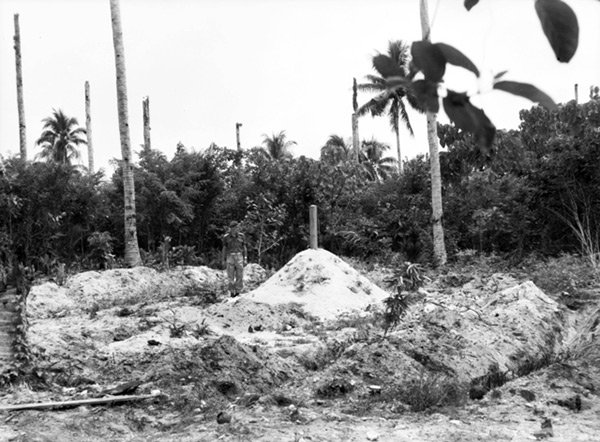
Graves Nov 10, 1945

Graves Nov 10, 1945 |
World War II
The Japanese arrived in early 1942 without resistance. They built a single crushed coral runway that spanned the length of the island. It was developed the island into a forward airbase, that was an important base for both their Navy and Army during early-mid 1943. Hundreds of Allied bombing missions and naval bombardments destroyed the base and littered the island with wreckage. The island was bypassed and left to 'wither on a vine'.
In November 1945, the first Australian Army soldiers arrived and made a shocking discovery: a mass grave of Allied Prisoners Of War (POWs) that were later identified as British Army soldiers captured at Singapore and brought to the island as laborers. All perished from Allied bombings, disease and the remainder were executed by the Japanese.
Edith McDonald, the prewar owner of Ballale Island had spent the war years in Australia. The war had been particularly cruel to her. The Japanese had leveled their plantation to build a runway that spanned the length of the island, and converted nearly every inch of its terrain into an airbase. Hundreds of Allied bombing missions and Naval bombardments left the land pot-marked with bomb craters, and everywhere were shattered remains of aircraft, equipment and munitions.
Post War Years
In the late 1940s and early 1950s most other islands and former military bases were promptly visited by scrappers who methodically worked over a location for profit: melting down the copper, brass and aluminum left from the war. Some of these profiteers made huge fortunes.
Unlike planters in nearby Papua and New Guinea, which received hefty reparations for war damages, those in the Solomons received none. At Ballale, there was little hope of re-opening the copra plantation without startup funds. Edith McDonald, was proud, principled and cared deeply for the local people. Even though financial pressures mounted, she declined an offer to have the island's war material salvaged, probably in hopes of doing the work herself when the plantation re-opened.
McDonald's decision not to scrap the island resulted in the protection of its wartime wreckage for a quarter century. Instead, the island languished with only the jungle reclaiming it. No local people lived on the island, aside from occasional hunters who passed there, or spent the night during bad weather. Locals recalled how some of the planes were still in near perfect condition their gauge still were intact, and some remembered flipping switches that caused lights to shine or radios to crackle. According to them, outsiders (white people) began to visit and began removing things from them. |
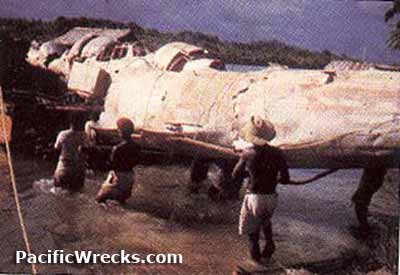
Diemert's 1968 Salvage
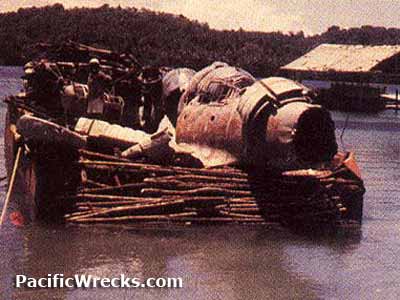
Barge Loaded
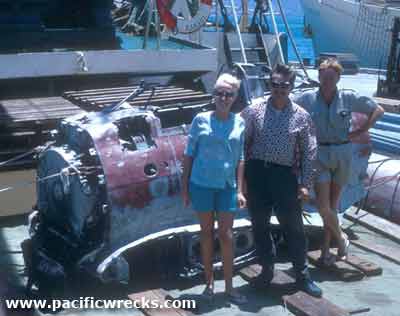
Barged to Port Moresby
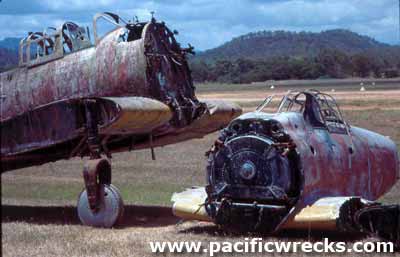
Wreckage at Port Moresby
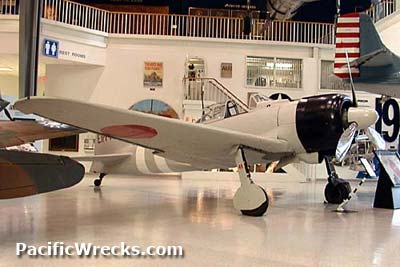
A6M2 5450 at NMNA
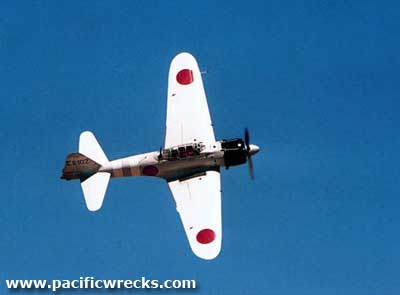
A6M2 5356 flying with CAF
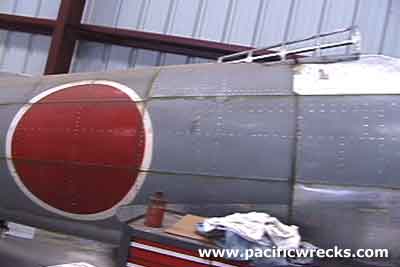
D3A2 3178 stored at
Planes of Fame
|
1968: First Salvage by Robert Diemert
Nearly a quarter century had passed since the war. Ballale's time-capsule was about to be broken. In the late 1960s, Canadian Robert Diemert arrived in the south Pacific. He was a pilot, mechanically minded, and later would proclaim himself to be the first 'restorer' of WWII aircraft in the early 1960s, before the warbird craze swept the world. In 1969, he had just finished working on the movie "The Battle of Britain" where he had restored and flown Hurricane fighter for the film.
Flush with confidence and cash from the film, he figured he would go to the Pacific and salvage a Zero and a Val in hopes of restoring them to flying condition for use in the Hollywood movie "Tora Tora Tora!".
In the late 1960s, Diemert consulting with Bill Chapman a resident of Port Moresby in Papua New Guinea who was interested in war relics and founded The Air Museum of Papua New Guinea. In 1968, Diemert visited Chapman befriended him and he suggested he go to Ballale Island and southern Bougainville as two placed where Japanese aircraft remained.
In the late 1960s, expatriates living in Bougainville
who were interested in history had begun salvaging war relics and restoring some of them for display locally. When Diemert arrived on the scene a number of Zeros had already been salvaged from Kahili Airfield (Buin) on southern Bougainville.
Across the international border in the Solomon Islands was Ballale Island and also known to have Japanese aircraft wreckage. In the late 1960s, enforcement and law in the islands was lax with frequent border crossings by locals and expatriates alike. With the help of the Catholic mission, Diemert enlisted local youths to clear the bush including school kids. Diemert and locals under his direction cut aircraft into pieces using hand tools including a hacksaw and pliers.
During the salvage, Diemert only snapped a handful of photographs showing planes being removed.
Maybe, he had no interest in documentation or historical integrity. More likely, he probably feared authorities were on the way to stop him. Operating quickly, Diemert loaded as much wreckage as possible into a barge.
Diemert's salvage a barge full of aircraft and parts including 1)
D3A2 Val 3178 a nearly intact dive bomber wreck 2) D3A2 Val 3077 one wing and parts. He also salvaged at least three A6M Zeros:
The salvaged material was shipped back to Port Moresby and by December 1968 it was stored outdoors in a pile at Jackson Airport where it was photographed and explored by curious expatriates. If Diemert make any notes or sketches, he's never shared them publicly. His lack of documentation has confounded efforts to properly identify the material he salvaged, or might have been a deliberate effort to obfuscate their providence.
he salvaged but from photographic evidence most of what he recovered has been determined. Diemert salvaged D3A2 Val 3178 plus one wing and parts from D3A2 Val 3077. VAL and three Zeros aboard his barge. Since the planes were intact, their wings and tails would have to be cut off (not disassembled). In a move that makes today's preservationists cringe, he use an axes to cut the wings and tails off! His visit was cut short with a violent case of scrub typhus he contracted on the island and rush to the hospital. He left with only one barge load of booty, that sailed back to Port Moresby. After narrowly recovering from his illness, Diemert convinced the RCAF (Royal Canadian Air Force) to pick up the relics in one of their transports flying via Port Moresby, and air lift them back to Canada for free... in exchange for one of the (the Val) for their museum.
Diemert Restorations of Salvaged Japanese Aircraft
Back in Canada, at his workshop at Friendship Airfield, Diemert began restoring the salvaged aircraft.
He first restored D3A2 Val 3178 to flying condition with a Wright R-2600 radial engine and made an unregisterd first flight on November 22, 1969 and was flown to RCAF Station Macdonald before delivery to the Canadian
National Aviation Museum in exchange for the transportation services provided by the RCAF.
Next, he restored three Zeros: one crashed, one was restored to static condition and the third to flying condition. The first A6M2 Zero 4461 crashed in 1973 due to a landing gear failure. He The second A6M2 Zero was restored to static condition and sold to the U.S. Marine Corps Museum (USMC Museum). The third A6M2 Zero 5356 was restored between 1973–1985 with a Pratt & Whitney R-1830 radial engine and sold it to the Confederate Air Force (CAF).
In the late 1960s and 1970s he restored and performed flight tests for several Japanese aircraft. On November 22, 1969 D3A2 Val 3178 that made an unregisterd first flight on November 22, 1969 and was flown to RCAF Station Macdonald to avoid Transport Canada officers.
Diemert was not involved with Tora Tora Tora! that used American AT-6 Texans with cosmetic changes to make them look like Japanese aircraft. A Canadian documentary The Defender (1998) follows his exploits and includes some footage of his restoration of the A6M2 Zero 5356 for the CAF. In 1990,
Diemert sold the remaining Zero parts to Blayd Corporation who used the original parts to create a newly built A6M2 Zero (Reconstruction) that was restored to flying condition in 2004. Today, the Zeros and Val salvaged by Diemert are considered 'priceless' by the organizations that own them.
Ballale Airport Reopens
Back in Australia, the McDonald decedents were unaware of the salvages from their island (until contacted for research related to this article), and received no notification or compensation for them. Unrelated, they took actions in the early 1970s related to their island. Lillian Dickes, the daughter of Edith acknowledged the family plantation would not be re-opened, and donated the runway and dock area to the government of the Solomon Islands, so that some infrastructure would be available to the people of the area. The remainder went to the "Balalai Development Company, Ltd." to administer the island.
A group of British engineers, working with local laborers (school children from nearby Nila Mission School) cleared the overgrown runway, and moved unexploded munitions. For the first time in thirty years, aircraft could again take off and land on Ballale.
During the 1970s, the repaired runway brought visitors made their way to the island, including including Charles Darby whose photographs appeared in his seminal book Pacific Aircraft Wrecks... And Where To FInd Them. Another early visitor was William Bartsch whose photographs appeared in an article about the Solomon Islands in After The Battle Magazine. These published photos and tales from early visitors circulated in aviation circles worldwide. Imagining an island of aircraft wrecks inspired many dreamers. Some wanted to simply visit this place to see it for themselves themselves while others schemed on ways to recover the aviation treasures.
Reported Salvages
In the 1970s, Allardyce Lumber began logging on nearby Shortland Island. Expatriates managers were stationed in the area as managers and on weekends, they visited the island and collected bits and pieces for themselves. When a manager completed their work, they often took a Japanese machine gun or other relic home as a souvenirs. During this period, another wreck reportedly went missing (unconfirmed) to aviation enthused logger.
An American, Patrick Murphy had become involved in the Solomon Islands and World War II when he moved there in the early 1990s. Winning the respect of the former prime minister, he imported weapons and outdated defense systems for the Solomon Islands. He began collecting war relics and excavated the crash site of A6M2 Zero 3647. By the late 1990s, he had fallen out of favor with the Solomon Islands government and was asked to leave the country. Around that same time, he traveled to Ballale, after befriending politician Dominic Otuana.
Reportedly, when he arrived, he asked Faruo
Islanders to assist in transporting a Zero (identity unknown) to Bougainville
for export. Lawrence Kibule, witnessed the happenings: "It is true, an American man named Patrick Murphy got three boys from Fauro
Island, to have him take a fighter airplane from Ballale. He
told them he would pay them $10,000 but only gave them one case of beer. When he left they knew he had lied. They never saw him again." Today, the only traces
of these reported salvages is an abandoned bulldozer and another missing wreck that has not resurfaced in any warbird collection or museums to date.
The Bougainville Crisis
Ballale had a small role during the "Bougainville Crisis" 1988–1998 between the Papua New Guinea Defense Force (PNGDF) and the Bougainville Revolutionary Army (BRA). During the crisis, Bougainville rebels visited the island in search of weapons and explosives to use against the PNGDF that were armed with modern weaponry. Most of the machine guns from the island's wrecks were spirited away, in hopes they would turn the tide of battle. What used were aerial bombs left on a portion of the island. These bombs were emptied of their cordite cores, to be used in homemade bombs. It is unclear if any of these explosives or weapons were actually used, or if they inflicted more casualties on the collectors than their enemies. Fifty years after WWII, the former weapons of war and their explosives were used again!
|
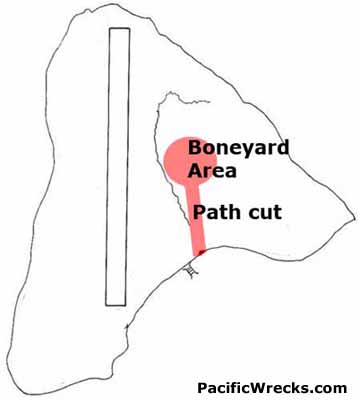
Map of salvage
December 2005
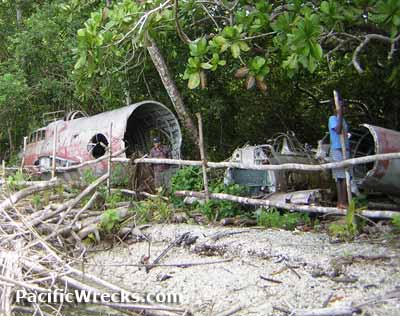
Wrecks collected for salvage
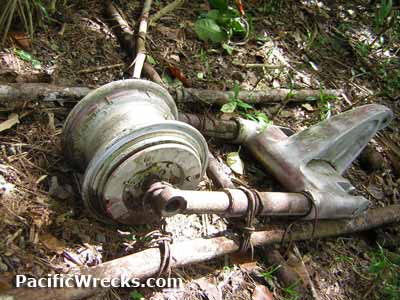
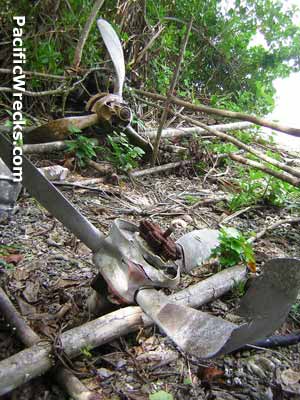 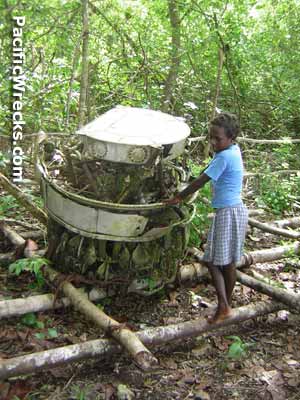
Collected for salvage
|
Salvage of More Wrecks 2005–2007
Most recently, new faces have taken an interest in the relics on Ballale and hoped to export and sell some, or all of them.
In the late 1990s Canadian, Chris Cowx visited the area as a tourist. He was amazed at the relics in the Solomons, particularly at Ballale. He began to inquire about buying wrecks, and presented to the local people and politicians, an plan for a community development project funded by selling some of the aircraft from Ballale.
In 2003, Australian Craig Turner, a self-appointed advisor to the Solomon Islands National Museum was issued a permit to export war relics, in exchange for help he would offer to the museum. According to Cowx, he and Turner work together, even traveled to Ballale, but problems developed and Cowx left the agreement. A back and forth sparring in the form of letters to the editor between Cowx and Turner unfolded in the Solomon Island Star Newspaper about Ballale and its wrecks, between November 2005–January 2006.
Proceeding solo, Turner tagged wrecks with red cloth for removal. Primarily A6M Zeros, a D3A2 Val and G4M1 Betty. Also engines, propellers and other smaller parts. Around December 2005, thirty or more locals were hired to man-handle the aircraft from a bone yard area over a cut path to the beach. There, the salvage halted. Locals were in disagreement about proposal and their end of the deal, particularly Farou Islanders who were the traditional landowners of the island, and against the salvage.
According to the Solomon Islands National Museum, the salvage from Ballale is is to help build a new "War Museum Wing" at the museum. The potential sale will benefit the museum, local people and Australian advisor, Craig Turner in equal thirds. Instead of selling relics, did the museum contact aid donors to contribute to museum improvements? Such organizations and governments been generous with the museum, including the donation of a Youth Center at the museum dedicated in 2003. Past museums include Myanmar Association, Sendai-Japan, Solomon Kitano Mendana Hotel and the Japanese Government.
On November 6, 2007 Craig Turner and Gary Spoors / GJD Services Ltd returned to complete the salvage. On November 8, 2007 this aircraft was loaded aboard Solomon Islands Government barge MV Tina plus other aircraft from the area. Footage of this Zero being salvaged appeared in OneNews: Shortland & Ballalae Aircraft Salvage" aired on November 20, 2007.
The salvage included at lease six aircraft including: A6M3 Zero (no. 1), A6M3 Zero (no. 2), A6M2 Zero 2487, A6M2 Zero 7434 from Ballale Island plus F1M2 Pete 1250 and F1M2 Pete 5269 from Magusaiai
Island and Poporang Island. The salvaged aircraft were transported to Honiara and stored briefly before being exported overseas.
Since the end of 2007, the precise whereabouts of this aircraft are unknown but presumed to be owned by Craig Turner and placed into storage in Australia, likely around Austral or some other location around Sydney.
Aside from an article in Classic Wings Magazine "Solomon Salvation" praising the salvaged, was no other press coverage. Presumably, this article was designed to spark interest from buyers. In July 2018, an A6M3 Zero removed was offered for sale for $195,00 USD in Classic Wings July 2018. Like other Japanese aircraft salvaged and offered for sale, actually interest and offers from well funded buyers seem scarce. |



B. Kotaru Sept 27, 2018
|
Salvage of Last Intact Wreckage 2018
By early October 2018, the last intact wrecks on Ballale were removed to the beach area. As of October 23, 2018 these aircraft were awaiting export. The aircraft removed included: 1) G4M1 Betty 2806 2) G4M1 Betty 1800 and 3) G4M1 Betty (early model rear fuselage) and 4) A6M2 Zero Sakae engine. Likely, other aircraft were also removed. The salvaged aircraft were moved to the beach awaiting export.
The salvager is reported to be "Warbird Restoration Pty Ltd" an Australian private company registered on July 1, 2017 (ABN 45 620 122 554) registered to director Robert Greinert and Rosemary Szabo of Wombarra, New South Wales 2515.
The Future
None of the recovered aircraft have ever be returned to Ballale or the Solomon Islands. The dozens of aircraft salvaged are now part of private collections and added to the collections of aviation museums in United States. Their value is estimated to be several million U.S. dollars.
If the local community choose to sell their aircraft, hopefully they will learn form the lessons of the past and get paid up front for their fair and full market value.
Hope still remains that the local community and Solomon Islands government will support sustainable tourism and visits to this location instead of having the last aircraft removed to foreign buyers.
Contribute
Information
Do you have photos or additional information to add?
References
Pacific Islands Legal Information Institute "Laws of the Solomon Islands – Protection of Wrecks and War Relics Act" 1973, 1980, 1991 [RTF]
YouTube "OneNews: Shortland & Ballalae Aircraft Salvage" November 20, 2007
GJD Services - Solomon's via WaybackMachine.org February 25, 2008
Classic Wings Volume 15, Issue 64 "Solomon Salvation" pages 48-49
Australian Government ABN 45 620 122 554 - Warbird Restoration Pty Ltd registered June 29, 2017 directors Robert Greinert and Rosemary Szabo of Wombarra, New South Wales 2515
Classic Wings Issue 108 Volume 23, No. 5 July 2018
"Mitsubishi A6M 'Zero' US$195,000 This substantial project provides an excellent basis for a Zero restoration. The cockpit interior is very complete with very few items having been removed. An instrument panel and correct Japanese instruments have been sourced for the project. Includes the Sakae radial engine. We're not see many projects like this anymore."
The Island Sun "Call to stop selling war relics on Balalae Island" April 20, 2018
The Island Sun "WW II sites as an important piece to destinational marketing in SI" October 12, 2018
The Island Sun "Call to Stop Selling War Relics on Balalae Island" April 20, 2018
Gizo Exposed "Moving of world war 2 plane wrecks on the island airport of Balalae, Shortlands Islands" October 8, 2018
Solomon Star "Planes can be removed but not after signing of MOA" October 22, 2018
The Island Sun "Plane Thief Alert" November 2, 2018
The Island Sun "Wale Calls on Govt to Ensure SI's War Relics Remain Protected" November 2, 2018
Email correspondence Robert Diemert, Patrick Murphy, Lawrence Foanaota, Chris Cowx and Craig Turner.
|
|